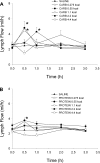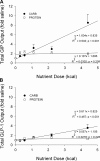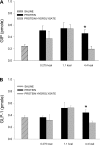Differential responses of the incretin hormones GIP and GLP-1 to increasing doses of dietary carbohydrate but not dietary protein in lean rats
- PMID: 20522638
- PMCID: PMC2928540
- DOI: 10.1152/ajpgi.00432.2009
Differential responses of the incretin hormones GIP and GLP-1 to increasing doses of dietary carbohydrate but not dietary protein in lean rats
Abstract
Previous studies have shown that oral ingestion of nutrients stimulates secretion of the incretin hormones glucose-dependent insulinotropic polypeptide (GIP) and glucagon-like peptide-1 (GLP-1); however, it is unclear whether there is a dose-dependent response between the amount of nutrient ingested and the secretion of the hormones in vivo. Using our lymph fistula rat model, we previously demonstrated that both GIP and GLP-1 responded dose dependently to increasing amounts of infused dietary lipid and that the GLP-1-secreting cells were more sensitive to changes in intestinal lipid content. In the present study, we investigated the dose-dependent relationships between incretin secretion and the two remaining macronutrients, carbohydrate and protein. To accomplish this objective, the major mesenteric lymphatic duct of male Sprague-Dawley rats was cannulated. Each animal received a single bolus (3 ml) of saline, dextrin, whey protein, or casein hydrolysate (0.275, 0.55, 1.1, 2.2, 4.4 kcal) via a surgically inserted duodenal or ileal feeding tube. Lymph was continuously collected for 3 h and analyzed for GIP and GLP-1 content. Both GIP and GLP-1 outputs responded dose dependently to increasing amounts of dietary carbohydrate but not protein. Additionally, we found that the GIP-secreting cells were more sensitive than the GLP-1-secreting cells to changes in intestinal carbohydrate content.
Figures






References
-
- Baggio LL, Drucker DJ. Biology of incretins: GLP-1 and GIP. Gastroenterology 132: 131–157, 2007 - PubMed
-
- Bollman JL. A cage which limits the activity of rats. J Lab Clin Med 33: 1348, 1948. - PubMed
-
- Bollman JL, Cain JC, Grindlay JH. Techniques for the collection of lymph from the liver, small intestine, or thoracic duct of the rat. J Lab Clin Med 33: 1349–1352, 1948 - PubMed
Publication types
MeSH terms
Substances
Grants and funding
LinkOut - more resources
Full Text Sources
Medical

